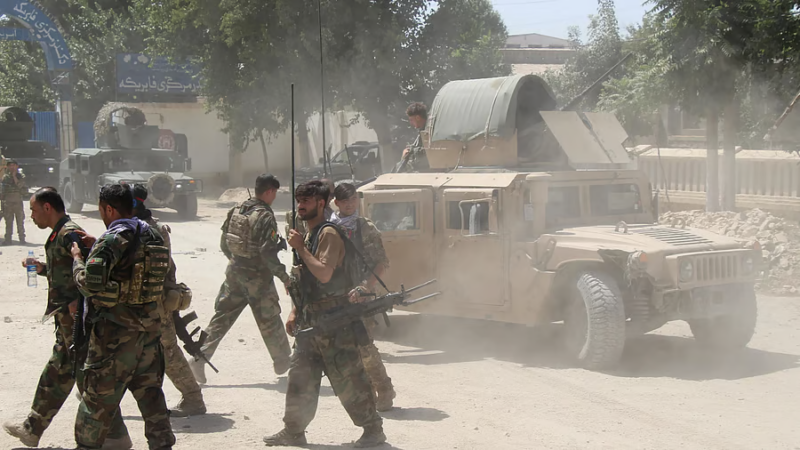What options does Biden have in Afghanistan?

Withdrawing US troops in May could derail the Afghan peace process. So, what can the new US administration do?
On December 2, 2020, the Afghan government and the Taliban announced an agreement on the procedural framework document that will act as a code of conduct during their peace negotiations. Shortly afterwards, the teams exchanged their respective agenda lists and announced a weeks-long hiatus.
Although the teams resumed their talks on January 6, the sides have made little progress and have only met a few times. It appears both the Afghan sides are waiting for clarity from the Biden administration on their approach to Afghanistan instead of focusing on progress in talks. The administration has thus far issued vague statements regarding a review of the agreement and assessing the Taliban’s progress in fulfilling their commitments.
Despite its shortcomings, the US-Taliban agreement and consequent intra-Afghan negotiations provide a singular opportunity to bring peace to war-torn Afghanistan and end the United States’s longest war. With the peace talks progressing slowly and the May deadline for withdrawal fast approaching, the Biden administration will have to make some difficult decisions.
There are no easy solutions regarding Afghanistan. If the US withdraws before significant progress has been made in intra-Afghan talks, there is a risk the entire process could collapse and result in renewed violence. If the US and NATO decide to keep their troops on the ground beyond the May deadline – as recent reports have indicated – it could result in an abandonment of the agreement and a renewed conflict with the Taliban.
The Biden administration has several policy options to address the crisis.
Full withdrawal by May
One policy option would be to abide by the withdrawal schedule set up by the Trump administration. President Joe Biden has shown unease with putting US troops in harm’s way in Afghanistan even before the US-Taliban agreement was concluded.
A full US military withdrawal by May, however, leaves two major issues unaddressed. First, the presence of the US military in Afghanistan has ensured a military equilibrium between the two negotiating sides. Although the US has reduced its military engagement, its continued presence has prevented the Taliban from tilting the balance of power on the ground in its favour.
In the case of a full withdrawal of foreign troops, unless the parties can make rapid progress in talks – which is unlikely – both sides would seek to exert pressure on each other in the military theatre. Any significant alteration in the battlefield could complicate the peace talks and make political compromise more difficult. Furthermore, the Taliban could abandon the peace process altogether, perceiving the other side as significantly weaker, and attempt to take power by force.
Following the agreement largely unencumbered by US air raids, Taliban fighters have been shutting down main highways and pushing government security forces to the confines of urban centres or large military installations. Their success in storming previously impregnable areas has reinforced their perception that Afghan security forces could crumble in the face of a series of focused offensives.
Second, unless a compromise between the two sides is reached, neither the Afghan government nor the Taliban will be in a position to prevent threat projection from smaller terror groups. Hardline armed groups will continue to exploit the security vacuum to operate in the country and possibly plan acts abroad.
That is why it seems less likely the Biden administration will go for this option.
Retaining a residual force
Given the risks a complete withdrawal could bring, the new administration could consider leaving behind a small US military force, focussed exclusively on counterterrorism. This force would also act as an equaliser in the military theatre and discourage outside interference.
As the US-Taliban agreement stipulates that all non-diplomatic foreign military personnel must leave Afghanistan, the US cannot retain such a force unless they either renegotiate the US-Taliban agreement or completely ignore it.
It is extremely unlikely the Taliban will agree to host a residual foreign force in the foreseeable future. The group has consistently stated that the presence of even a single foreign troop makes jihad an obligation on all Afghans. If international troops remain without some form of agreement, the Taliban leadership will be unable to enforce adherence to the current deal as Hanafi jurisprudence – which the group follows – stipulates that when a central clause of a treaty is abandoned or breached, then it amounts to the abrogation of the entire agreement.
Its military successes in recent years and the political recognition it has received from most regional powers have convinced the armed group that if a political solution fails, it can continue to expand its military operations.
This would likely mean the Taliban will renew attacks on foreign forces and urban centres and potentially provide sanctuary to foreign armed groups again. Even if US airpower is able to prevent a total collapse of the Afghan army, the fighters would continue with their current strategy of confining government presence to major urban centres and ramping up violence in government-controlled areas. To push back against such an escalation, the US would then need to bring its military presence back to the pre-agreement levels.
In other words, a residual force, regardless of its size or scope, would most certainly result in prolonging the two-decade war.
A short-term extension of withdrawal deadline
A third option for the US would be to seek a short-term extension of the withdrawal deadline to address key US policy concerns and accelerate progress in the peace talks. The Biden administration can seek this extension in two different ways: It can either claim that the Taliban has not fulfilled its obligations under the agreement, as some of its officials seem to be doing right now, or seek to renegotiate the agreement without pushing for a residual force.
Suspending the withdrawal by claiming the Taliban have not fulfilled their obligations such as preventing armed groups from being based in areas under their control or failing to reduce violence would provide short-term respite but leave important issues, such as continued commitment to a political process or long-term prevention of “terrorism”, unaddressed.
Based on past behaviour, the Taliban will adopt a literalist approach in fulfilling its obligations and seek to limit the scope of discussions to issues pertaining to non-performance. It is worth recalling that the group chose extremely precise wording pertaining to their obligations, omitting a clear commitment to publicly cut ties with armed groups. This will enable them to make a case that they have fulfilled their obligations or that they are only required to fully prevent foreign armed groups from operating from Afghanistan after all foreign troops withdraw from the country.
Demands, such as publicly severing ties with al-Qaeda or actively fighting against foreign groups, will be viewed as deviations from the letter of the agreement. Insistence on such new obligations or wider negotiations in this context might be viewed as malignant and risk unravelling the entire agreement.
Actions such as a unilateral extension of the withdrawal deadline by the US will be risky and could provoke the Taliban into retaliatory measures. This could risk serious repercussions that would bring the entire agreement into question and potentially derail the peace process.
A more prudent approach would be to seek a short-term extension through negotiations. The new US administration can signal that it seeks a revision of the agreement and clarifications. This would be possible given the many ambiguities in the agreement in how certain provisions are worded, including the requirement for reduction in violence by all sides, the areas which fall within the violence-de-escalation provision, the use of international forces to support the Afghan army, and the Taliban’s obligations vis-a-vis foreign groups.
However, there is no guarantee the Taliban will consent to a short-term extension. There is growing resistance within the Taliban to the ongoing peace process. Other than the release of 5,000 prisoners, all other obligations towards the group remain unfulfilled. As mentioned above, unless progress is made in talks, or other provisions of the agreement are fulfilled, the Taliban might be tempted to step away from the political process and refocus on its military campaign.
To maximise the chances of gaining the Taliban’s consent for an extension, the US should focus its efforts on fulfilling certain portions of the agreement and expediting the intra-Afghan peace process. For example, the new administration can begin delisting Taliban leaders from US sanctions lists and facilitating further prisoner exchanges. However, even if Washington manages to negotiate an extension, it would not be more than a few months long.
Expediting the intra-Afghan talks
While seeking to postpone full withdrawal, the US should also seek to accelerate the talks between the Taliban and the Afghan government. Otherwise, it risks facing the same dilemma when the new withdrawal deadline approaches.
To avoid this scenario, the Biden administration needs to engage in more aggressive diplomacy and put more effort into building regional consensus to support the peace process.
While the Trump administration made major strides on this front, its advances were hindered by some of its controversial policies, including the trade war with China and the maximum pressure campaign against Iran. India has also remained ambivalent while the EU has, at times, criticised the current approach.
President Biden can seek to involve China and Russia more directly in the peace process in Afghanistan and reach out to Iran. Building regional support for the peace process is crucial because it would prevent both the Afghan government and the Taliban from playing regional powers against the US. This would allow the Biden administration to use its leverage over the two sides with greater efficiency.
The Afghan government relies heavily on the US for financial assistance while the Taliban knows its political viability will depend on international recognition and assistance guaranteed by the US. Continued US engagement, including the recognition of any new government, financial assistance, and future investments, remains the Biden administration’s strongest leverage over both sides to the conflict.
The success of this approach is far from guaranteed, but if the US cannot negotiate an extension, it will have to choose between a withdrawal in May and a resumption of the conflict. At this point diplomacy still appears to be more useful in resolving the Afghan conflict than the failed military approaches of the past two decades.
The views expressed in this article are the author’s own and do not necessarily reflect Al Jazeera’s editorial stance.






